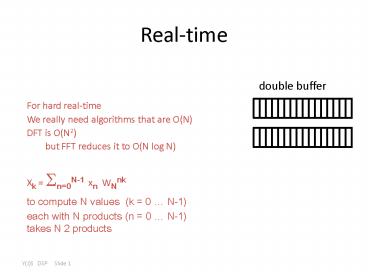Y(J)S DSP Slide 1 - PowerPoint PPT Presentation
Title:
Y(J)S DSP Slide 1
Description:
DIT FFT. separate sum in DFT. by decimation of x values ... DIT is PIF. comparing frequency values in 2 partitions ... DIT all the way. We have already saved ... – PowerPoint PPT presentation
Number of Views:24
Avg rating:3.0/5.0
Title: Y(J)S DSP Slide 1
1
Real-time
double buffer
- For hard real-time
- We really need algorithms that are O(N)
- DFT is O(N2)
- but FFT reduces it to O(N log N)
- Xk Sn0N-1 xn WNnk
- to compute N values (k 0 N-1)
- each with N products (n 0 N-1)
- takes N 2 products
2
2 warm-up problems
- Find minimum and maximum of N numbers
- minimum alone takes N comparisons
- maximum alone takes N comparisons
- minimum and maximum takes 1 1/2 N comparisons
- use decimation
- Multiply two N digit numbers (w.o.l.g. N binary
digits) - Long multiplication takes N2 1-digit
multiplications - Partitioning factors reduces to 3/4 N2
- Can recursively continue to reduce to O( N log2
3) ? O( N1.585)
3
Decimation and Partition
x0 x1 x2 x3 x4 x5 x6 x7
Partition (MSB sort) x0 x1 x2 x3 LEFT x4 x5 x6
x7 RIGHT
- Decimation (LSB sort)
- x0 x2 x4 x6 EVEN
- x1 x3 x5 x7 ODD
Decimation in Time ? Partition in
Frequency Partition in Time ? Decimation in
Frequency
4
DIT FFT
If DFT is O(N2) then DFT of half-length signal
takes only 1/4 the time thus two half sequences
take half the time Can we combine 2 half-DFTs
into one big DFT ?
separate sum in DFT by decimation of x values
we recognize the DFT of the even and odd
sub-sequences we have thus made one big DFT into
2 little ones
5
DIT is PIF
We get further savings by exploiting the
relationship between decimation in time and
partition in frequency
Note that same products just different signs
- - - -
comparing frequency values in 2 partitions
Using the results of the decimation, we see that
the odd terms all have - sign !
combining the two we get the basic "butterfly"
6
DIT all the way
- We have already saved
- but we needn't stop after splitting the original
sequence in two ! - Each half-length sub-sequence can be decimated
too - Assuming that N is a power of 2, we continue
decimating until we get to the basic N2 butterfly
7
Bit reversal
- the input needs to be applied in a strange order
! - So abcd ? bcda ? cdba ? dcba
- The bits of the index have been reversed !
- (DSP processors have a special addressing mode
for this)
8
Radix-2 DIT
9
Radix-2 DIF































